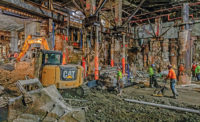

"Grueling ... terribly complicated ... demanding ... a burn-out kind of project." Michael Adlerstein, leader of the $2.1-billion renovation of the 17-acre United Nations headquarters in Manhattan, minces no words when describing the 2.5-million-sq-ft multi-building overhaul, headed for completion this summer after six years of reconstruction within an active U.N. campus.
Adlerstein, 68, also calls the fishbowl project "the top of the pile" of his career. That's a big endorsement from Adlerstein, who also led the Statue of Liberty's centennial restoration. "The U.N. is a functioning government, and you can't beat its mission [of world peace]," says the assistant secretary-general.
Appointed in mid-2007, architect Adlerstein was a replacement for the first executive director of the U.N. capital master plan. His predecessor threw in
 |
| ADLERSTEIN |
To stay the course, Adlerstein acts as diplomat, custodian and master builder. He keeps the 193-member General Assembly happy. He makes sure each secretariat department keeps functioning during the work. And he directs design and construction.
"He never succumbed to the constant pressure, completing each project while maintaining both his perspective and reasonable blood-pressure readings," says Paul Eagle, principal of Perkins+Will, the project's programmer-peer reviewer.
Adlerstein has not succeeded alone. He credits his staff, which peaked at more than 25, and a program manager, myriad designers, a construction manager with 23 separate contracts, 659 trade contractors and the workers, who peaked at 900 per day. "Michael kept a large and diverse team focused and working together smoothly and is, certainly, largely responsible for the project's success," says Robert A. Heintges, the senior partner of the design firm that bears his name.





Post a comment to this article
Report Abusive Comment